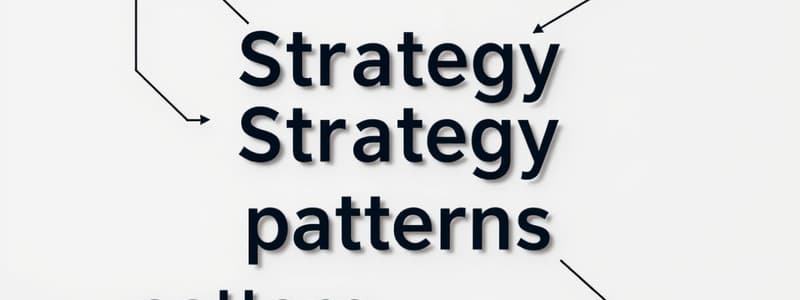Podcast
Questions and Answers
Which design principle emphasizes programming to an interface rather than an implementation?
Which design principle emphasizes programming to an interface rather than an implementation?
- Design Principle 1
- Design Principle 3
- Fly Behavior Principle
- Design Principle 2 (correct)
What does the Strategy pattern provide for algorithms within a system?
What does the Strategy pattern provide for algorithms within a system?
- It enforces a single algorithm for all cases.
- It focuses on inheritance rather than composition.
- It makes all algorithms immutable.
- It encapsulates and makes algorithms interchangeable. (correct)
What is the main purpose of encapsulating behaviors in an abstract class?
What is the main purpose of encapsulating behaviors in an abstract class?
- To reduce the number of classes in the system.
- To enforce a specific algorithm.
- To allow behaviors to be defined at compile time.
- To hide implementation details. (correct)
What aspect of an application does Design Principle 1 focus on identifying?
What aspect of an application does Design Principle 1 focus on identifying?
In the context of the Duck problem, what is a primary advantage of using interfaces?
In the context of the Duck problem, what is a primary advantage of using interfaces?
What does the phrase 'favor composition over inheritance' suggest?
What does the phrase 'favor composition over inheritance' suggest?
Which design pattern allows for varying algorithms independently of the clients that use them?
Which design pattern allows for varying algorithms independently of the clients that use them?
Why is the fly() method in RubberDuck defined to do nothing?
Why is the fly() method in RubberDuck defined to do nothing?
What are instance variables used for in the context of integrating Duck behavior?
What are instance variables used for in the context of integrating Duck behavior?
What is a major flaw highlighted with the Flyable/Quackable interfaces?
What is a major flaw highlighted with the Flyable/Quackable interfaces?
Flashcards are hidden until you start studying
Study Notes
Overview of Design Patterns: Strategy
- The Strategy Pattern is integral in software design, allowing algorithms to be defined, encapsulated, and made interchangeable.
- Encourages flexibility in algorithm selection and usage independent of client code.
SimUDuck Application
- Initial version involved a simple duck simulation app.
- Introduction of a feature for flying ducks, leading to complications.
Implementation Issues
- RubberDuck class exhibits peculiar behavior:
quack()method produces a "squeak."display()method showcases its rubber duck appearance.fly()method is overridden to do nothing, highlighting the problem of fixed behaviors.
Key Observations
- Interfaces like Flyable and Quackable may hinder code reuse, suggesting that as software evolves, flexibility is crucial.
- Design Patterns serve to separate varying components from stable ones, contributing to code maintainability.
Design Principles
-
Design Principle 1: Identify varying application aspects and isolate them from constant components. Applied to the Duck problem for better organization.
-
Design Principle 2: Emphasizes programming to interfaces rather than specific implementations. For instance, distinguishing fly and quack behaviors.
Duck Behavior Integration
- Utilizes an abstract class with instance variables that hold behavior references during runtime.
- The
performXXXmethod delegates operations to current behaviors, allowing dynamic behavior assignment. - Subclass constructors are responsible for initializing behaviors.
Composition vs. Inheritance
- Design Principle 3: Prioritize composition over inheritance to enhance modularity and reduce coupling in the system.
UML Representation
- The Strategy Pattern allows various algorithms to be encapsulated and swapped seamlessly, enhancing the architecture of applications.
Practical Example
- IArtistRepository interface showcases the concept of abstraction:
- Methods for retrieving and updating artist data.
- The ArtistService class uses dependency injection to receive an instance of IArtistRepository, promoting the Strategy Pattern's adaptability in service components.
Studying That Suits You
Use AI to generate personalized quizzes and flashcards to suit your learning preferences.




